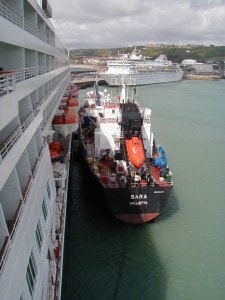In Russia we bunker fuel because the prices are good and we can get the low sulpher version that we normally burn during these cruises. One of vague things in St. Petersburg is the organization of when the bunker barge will arrive. We always try to get the barge in the morning, when most of the guests are ashore as the barge tends to make quite a bit of noise. The pump room aboard the barge can be quite loud and during the night time it would disturb the guests whose cabins are on the sea side. However finding out and getting a schedule is nearly impossible. Thus the announced time of early (last) evening did not materialize at all. By 11 pm. I decided to give the agent a call to find out what was going on. Due to the language barrier all communication has to go through the agency and they have a set up for this a 24 hrs. Dispatcher with his own VHF channel. It works extremely well. He made another call and suddenly the hours of waiting were reduced to 20 minutes. 20 Minutes Russian time has to be multiplied by 3 and indeed just before midnight the barge was alongside.
One who was not pleased at all about this scheduling was the chief engineer as he has to be present during the bunkering period. After waiting all day, he now had to be up and about during the night as well. Bunkering is an operation that is fraught with dangers if not well executed. So we have strict protocols in place and check lists in use. The situation is considered critical enough to warrant the continuous presence of the chief engineer to supervise the whole process. It does not mean that he takes care of the bunker process itself but he is around to ensure a safe and careful operation. Apart from the engine room procedures, care is also taken that nothing from “the outside” affects the operation. Guests receive notices in their cabins urging them not to smoke on the balconies above the barge during the bunkering hours and the lower promenade deck above the barge is roped off. No smoking signs are also placed on the top of decks in the vertical proximity of the barge. The bridge ensures that a Red flag is hoisted during the day and a red light is displayed during night time to indicate bunker operations in progress.
 A typical bunker barge. This photo was taken in July 2009 in Dover. Captain Albert Port Database.
A typical bunker barge. This photo was taken in July 2009 in Dover. Captain Albert Port Database.
A critical moment in the whole operation is always when bunkering is over and the chief engineer has to agree with the amount loaded. It is not as simple as with tanking petrol for the car. The pump at the tank station is tested on a regular basis to ensure that the correct volume of fuel is given out each time the pump is used. With Heavy fuel oil it is a totally different matter. The oil is heated when pumped onboard and the warmer it is the more it expands. Thus the tank in which the fuel is located is sounded to ascertain the amount in the tank, the transfer temperature is measured and when the transfer is complete the tank is sounded again to calculate the amount pumped. With taking the transfer temperature into consideration a final amount, in metric tons, (volume tons) is arrived at. Then the chief engineer and the barge operator both have to agree with the final figure and if so the receipt is signed. When there is disagreement the chief engineer will accept the amount listed by the barge operator “under protest” and indeed hands over a letter of protest. Then our buying agency (part of Carnival Corporation) will follow up and somehow sort the discrepancy out.
We did not receive any complaints in regards to the bunkering this time but we have had them in the past, hence we always try to organize refueling during the day time when most of the guests are gone.
Most of our guests were indeed off the ship and on tour today. With 8 cruise ships in port (Costa Luminosa, Aida Luna, Mein Schiff, Prinsendam, MSC Orchestra, Seabourn Pride, Silver Shadow, Ocean Majesty) it was extremely busy at the tourist hot spots. When I did a Baltic cruise as spouse, onboard my wife’s ship a few years ago and also in August, I counted over 200 tour buses at the Hermitage during one afternoon.
Therefore it was not unexpected that the tours were coming back late. As the all aboard time was 17.30 with a departure by 18.00 hrs. the last bus was back at 18.20 hrs. which was not bad at all for St. Petersburg standards. But the later I sail, the later I pass Kronstad for scenic cruising and I always try to be there before the show onboard starts at 20.00. This time we just made it. Everybody could have a quick glimpse of the old Imperial Navy base and decide whether to stay for the rest or to go to the show.
Tomorrow we are in Helsinki and we will be together with the Jewel of the Seas. I have been banned to the West harbour as downtown will be full of cruise ships and ferries that call on a regular basis. We had two rainy days in St. Petersburg and it will depend on the wind, whether it will be dry tomorrow. The forecast is nearly wind still weather and that might mean some lingering rain clouds over Helsinki.

Leave a Reply